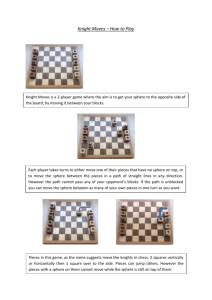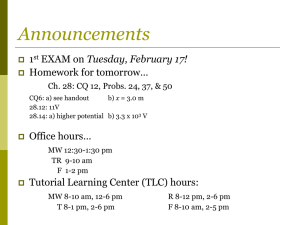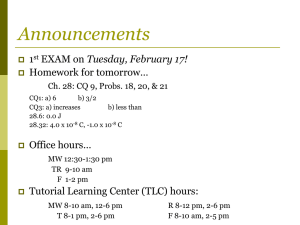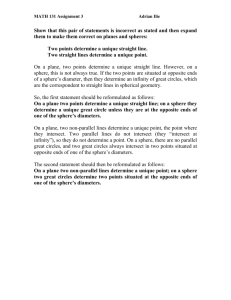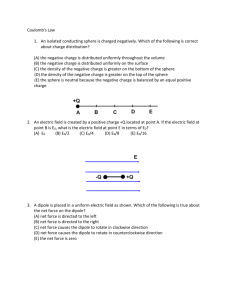Physics 205 lab 5 Electrostatics
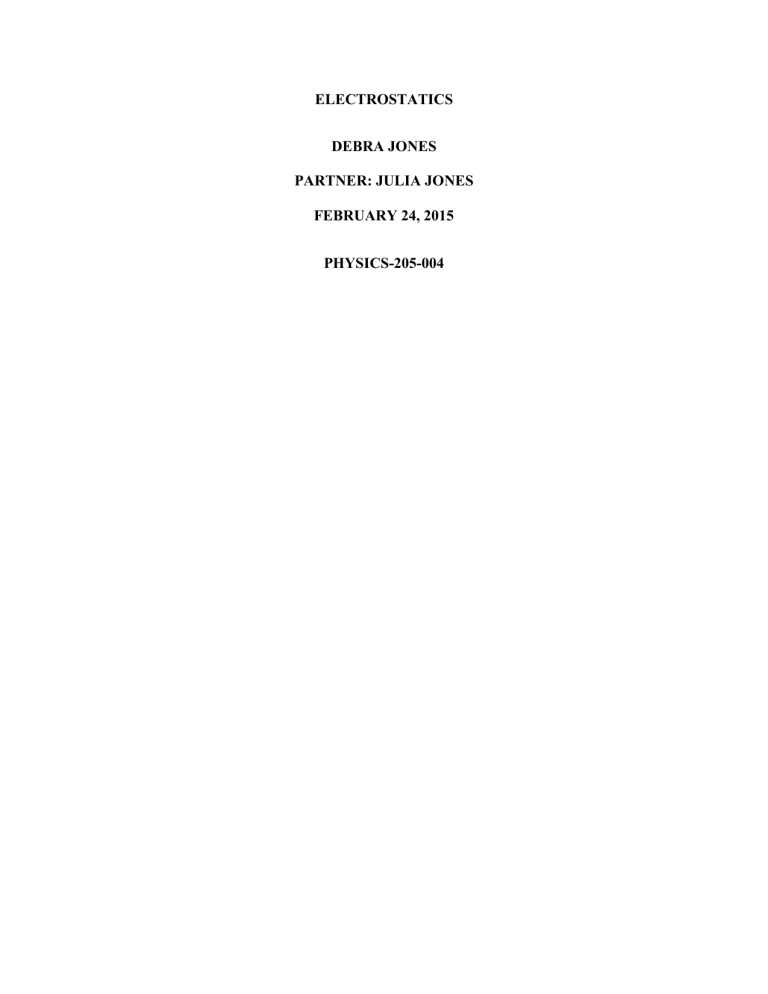
ELECTROSTATICS
DEBRA JONES
PARTNER: JULIA JONES
FEBRUARY 24, 2015
PHYSICS-205-004
Abstract
The purpose of this experiment was to observe how charge changes on materials that act as insulators and conductors. This was done in many stages. The equipment used in this lab was a Pasco Es-9077 Electrostatic Voltage Source, a Pasco Es-9078 Basic Electrometer, BNC cables,
Science Workshop 750 Interface, a Faraday Ice pail, banana clips, and a 100 pF low leakage
Polypropylene capacitor. The electrometer was first calibrated, and the known voltage and known capacitance were recorded. These values were found to be 30 V and 100 pF respectively.
The Faraday Ice pail was then connected to the Basic Electrometer. The Capacitor was charged to 30 V and then placed on the inner and outer parts of the Ice pail. The voltage was then measured to be 19 V. This measured value along with the known capacitance and voltage were then used to calculate the system capacitance, which was determined to be 57.9 pF.
The second part of the experiment examined the triboelectric effect where charge is exchanged between objects by friction when they come into contact. This was done by rubbing together one blue and one white charge producers and then inserting them individually into the
Faraday Ice pail to record their effect on the electrometer. The charge of the white charge producer was found to be 2.72 nC while the charge of the blue charge producer was -9.5x10
-1 nC. The blue charge producer created a negative charge while the white charge producer created a positive charge indicating that electrons were transferred to the blue charge producer.
Next, the charge distribution was measured over a metal sphere that was plugged into a voltage source of +3000 V. The charges of four sides of the sphere were measured and were found to be Q
1
=1.37 nC, Q
2
=1.33 nC, Q
3
=1.40 nC, and Q
4
= 1.40 nC. From the charge of Q
1
, the number of electrons present at that location was calculated to be 8.55x10
9
electrons. Next, the induced charge distribution was measured. This was done by placing a free sphere next to a charged sphere (3000 V). The charge was then measured on the four sides of the sphere, with Q
4 being furthest from the charged sphere. The charges were found to be Q
1
= -1.79x10
-11 C, Q
2
= -
1.27x10
-11
C, Q
3
= -2.895x10
-11
C, and Q
4
= 6.37x10
-11
C. The positive charge was on the point furthest from the charged sphere. Permanent induced charge distribution was measured by
The last experiment measured by first grounding one sphere and charging the other (with
3000V). Next, the four charges of the grounded sphere were collected and were found to be
-5.79x10
-11 C, 1.79x10
-10 C, -1.158x10
-10 C, and -6.89x10
-10 C respectively. Next, to measure the permanently induced charge, the grounding wire was disconnected, and the charges of the four sides were again measured, with Q
2
being the point furthest from the charged sphere. These charges were measured to be Q
1
= -2.859x10
-11
C, Q
2
= 9.84x10
-11
C, Q
3
= -2.895 x 10
-11
C, and
Q
4
= -1.0596x10
-10
C. This data shows that the negative charges were drawn to the positively charged conducting sphere.
The last experiment conducted was done to observe the effects of sharing charge distributions. For this experiment, a sphere was charged with 3000V. It was then touched to the free sphere, and the charges on the free sphere were measured. This procedure was done twice.
First, the charges on the connected sphere were measured and were found to be 5.9x10
-10
C,
4.6x10
-10 C, 5.38x10
-10 C, and 4.69x10
-10 C respectively. It was predicted that upon being touched with the free sphere, the charges on the free sphere would be one half of these measured
charges. Upon touching the free sphere to the charged sphere, the charges were found to be Q
1
=
2.6x10
-10 C, Q
2
= 2.6x10
-10 C, Q
3
= 2.6 x 10 -10 C, and Q
4
= 2.258x10
-10 C. These values are about one half of those that were calculated for the charged sphere. The free sphere was then grounded and again touched to the charged sphere. It was predicted that the new values on the free sphere would be one half of those recorded on the free sphere from the last trial. Experimentally, these charges were found to be Q
1
= 1.45x10
-10
C, Q
2
= 1.33x10
-10
C, Q
3
= 1.27 x 10
-10
C, and Q
4
=
7.5x10
-11 C. Again, these values were found to be about one half of those from the last trial. This shows that the half of the charge on the charged sphere is transferred to the free sphere upon them touching. One possible source of error for this experiment could be due to the human error of reading the voltage incorrectly on the computer screen. Since there was a wide range of values that were being recorded, it is possible that the incorrect value was chosen for this data.
Discussion
1) Humidity reduces the resistance of dielectrics, meaning that as humidity increases, the strength of the dielectric increases. This means that more voltage can be applied to a material before it begins to deteriorate. This could cause error in this experiment due to the material’s higher capability to hold a charge. This means that our results could be higher than expected due to the increased ability of the material used to hold voltage. It is better to perform this experiment on a dry day so that one can minimize error.
A) Q
0
=Q
0
Q
1
=Q
0
/2 Q
2
=Q
1
/2=Q
0
/4 Q
3
=Q
2
/2=Q
1
/4=Q
0
/8
Q
4
=Q
3
/2=Q
2
/4=Q
1
/8=Q
0
/16 Q
5
=Q
4
/2=Q
3
/4=Q
2
/8=Q
1
/16=Q
0
/32
B) Q n
=Q
0
/2 n
C) Q n
=Q
0
/2 n
-1.6x10
-19 C= -6.5536x10
-16 C/2 n
2 n = 4096
ln 2 n = ln 4096
n ln 2 = ln 4096
n = ln 4096/ ln 2 = 12
D) 12 iterations of this process produce the charge of a single electron.

